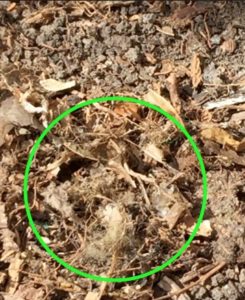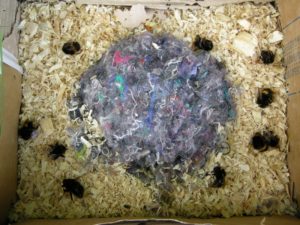The pest controller is coming to kill the bees
I was called out to this address, 2nd May, late morning, to suggest what to do with an active bee nest in the garden. It was in an area which was to be part of a lawn, with the whole garden about to be landscaped. The nest now delayed the work. It was under a shed that had been covering it then dismantled and completely removed. The bees were not too happy having their nest disturbed and ‘chased’ the owner’s husband away, who was n’t too happy either! The house owner was worried about her 18-month-old child, and they had an inquisitive dog that kept on going to the nest. That very afternoon a pest control company was to visit and kill the bees for £60. Could I help before they came?
Beneath the shed was as you would expect, bare dry earth. Except for a tiny mound of dried twigs and vegetation as shown above, which was the entrance to a still active Bombus terrestris nest, with workers coming and going from the mound.
Battlefield outside the nest entrance site
Upon close inspection of the mound I saw 6 dead B. terrestris queens in and around that area, just out of the picture. They were all completely dried, meaning they had been there a while and not fresh kills. I suspect that these may be the result of usurpation of the nest whereby true bumblebee queens, i.e. not cuckoo bumblebees, when looking for a suitable nest site fight for ownership of it. The original owner may well have been a victim herself. However a bumblebee colony was now developing with probably the eventual winner and now a foundress queen or even a cuckoo bumblebee such as B. vestalis? Film of B. vestalis checking out a nest box. Its impossible to state exactly what happened.
There are 10 dead B. terrestris queens inside this nest box, all dead, with one survivor inside the mound who went on to establish a successful colony. This is the most I have seen, although Prof. Goulson states in his book, ‘A sting in the tale’, that as many as 20 dead queens have been found at nest sites.
From a safe distance (!) the home owner asked what I proposed to do, (instead of filming?!!) I was about to tell here when I saw a B. terrestris worker emerge from the nest entrance carrying a live bee larva, and restarted to film! It was struggling to remove it away from the nest entrance. Eventually she dumped it and flew away.
“All my articles and videos, available free, are funded by my teaching, presentations, sales of award winning bumblebee nest boxes, solitary bee boxes, and wormeries. Please help by spreading the word and forwarding this link to your friends and colleagues. https://nurturing-nature.co.uk Thank you” George Pilkington
In the end I explained about the life cycle and probable duration of the nest, covered the nest with a large section of the old shed positioned so that bees could enter and leave facing the concrete rear fence panels away from the garden. This would protect the bees and the inquisitive dog would remain inquisitive and not be harmed. I suggested the area could be lawned at a later date with turf, they could make a rockery or put plant pots there filled with bee friendly flowers!! I think I persuaded the owner to allow the bees to complete their short life cycle and save herself £60.
This is an interesting paper re aspects of bumblebee including usurpation, worker drift and egg dumping. I thought these bees were known to be social!!
Interested in Citizen Science and pollinators? See The Buzz Club.
With thanks to Kevin Henry for the nest box photograph.




Well done, George.
“I thought these bees were known to be social” – well, yes, so are humans but not always!
Thanks Teresa. It’s worse if you read the science paper from link provided cheers George
Yes, an interesting paper, George. I am a big fan of Dave Goulson, having read his books and been fortunate enough to attend a talk he gave in Lewes (near me), last year.